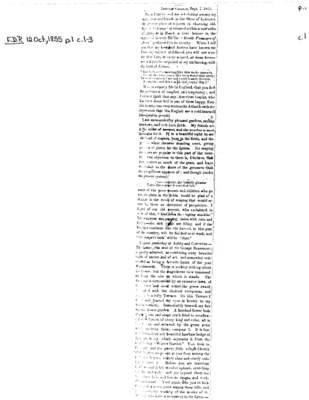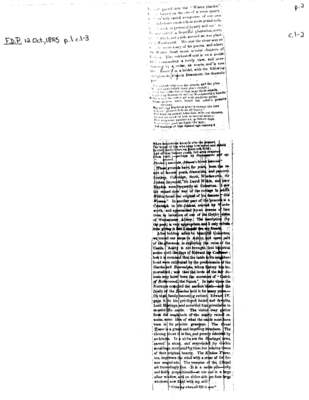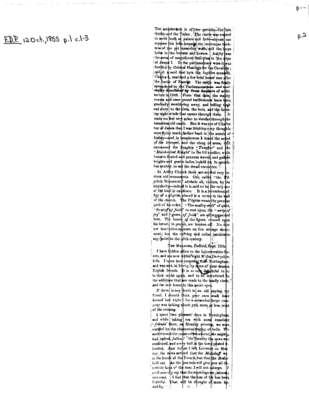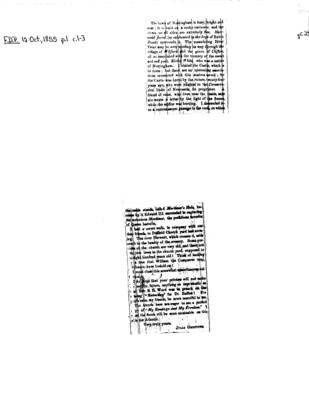Pages
D6866_Page_1
IBSTOCK GRANGE, Sept. 7, 1855.
DEAR FRIEND:—I am yet visiting among my many dear old friends in the Shire of Leicester. My present place of sojourn (a charming oldfashioned Grange) is situated within seven miles of Ashby de la Zouch, a town famous in the annals of history for the "Gentle Passages of Arms" performed in its vicinity. When I tell you that my host and hostess have known me from my earliest childhood, you will not wonder that I am, in every respect, at home here— nor will you be surprized at my exclaiming, with the bard of Erin—
"And doth not a meeting like this make amends, For all the long years I've been wand-ring away; To see thus around me my youth's early friends, As smiling and kind as in that happy day?"
It is in country life in England, that you find the perfection of comfort and hospitality; and I cannot think that any American tourist, who has been domiciled in one of these happy, English homes, can ever recross the Atlantic with the impression that the English are a cold-hearted, inhospitable people.
I am surrounded by pleasant gardens, smiling meadows, and rich corn fields. My friends are in the midst of harvest, and the weather is most favorable for it. It is a beautiful sight to see the band of reapers, busy in the fields, and the golden wheat sheaves standing erect, giving promise of plenty for the future. No reaping machines are popular in this part of the country. One objection to them is, I believe, that they scatter so much of the grain, and leave more of it to the share of the gleaners than the proprietors approve of; and though (under the present system) "—content the humble gleanor Takes the scatter'd ears that fall," many of the poor women and children who go out to glean in the fields would be glad of a change in the mode of reaping that would secure to them an extension of perquisites. I heard of one old woman, who exclaimed, in view of this," God bless the reaping machine." The waggons are passing, laden with oats and barley—the rick yards are filling, and if the weather continue fine, the harvest, in this part of the country, will be finished next week, and "the reaper's task" will be "done."
I spent yesterday at Ashby and Coleorton.— The latter, (the seat of Sir George Beamont.) is justly admired, as combining many beauties both of nature and of art, and somewhat celebrated as being a favorite haunt of the poet Wordsworth. There is nothing striking about the house, but the magnificent view commanded from the site on which it stands. The dwelling is surrounded by an extensive lawn, of the softest and most velvet like green sward, decorated with the choicest evergreens, and leading to a lofty Terrace. On this Terrace I stood and feasted my eyes in beauty to my heart's content. Immediately beneath my feet was the flower garden. A hundred flower beds of every size and shape (each filled to overflowing with flowers of every kind and color, all in full bloom, and relieved by the green grass which encircles them) compose it. it is bordered by a singularly beautiful haw-haw hedge of dark green ivy, which separates it from the neighboring "Winter Garden." You look to the right and the pretty little village Church of Coleorton peeps out at you from among the noble beech trees, stately elms and sturdy oaks that environ it. Before you are luxuriant meadows and richly wooded uplands, stretching out, far and wide, and yet beyond them rise the distant hills, and forests, ranges, and rocks of Charnwood. Your guide tells you to look steadily at a given point among those hills, and you discern the oratory of the monks of St. Bernard, who have a monastery in the forest.—
D6866_Page_2
We next passed into the "Winter Garden." which is formed on the site of a stone quarry, and filled with varied evergreens of our own clime, and choice exotics from more genial soils, which flourish in perennial beauty and verdure. We next visited a beautiful plantation, every tree of which, our guide assured us, was planted by Wordsworth. We saw the stone seat on which he wrote many of his poems, and where Sir Walter Scott wrote several chapters of IVANHOE. This celebrated seat is on a gentle hill commanding a lovely view, and overshadowed by a cedar, an acacia, and a rose tree. Above it is a table, with the following inscription to Francis Beaumont, the dramatic poet: The embow'ring rose, the acacia, and the pine Will not unwillingly their place resign; If but the cedar thrive that near them stands, Planted by Beaumont's and by Wordsworth's hands. One wooed the silent art with studious pains, These groves have heard the other's pensive strains; May Nature's kindliest powers sustain the tree, And love protect it from all injury! And when its potent branches, wide out thrown, Darken the brow of this memorial stone— Here may some painter sit in future days, Some future poet meditate his lays; Not mindless of that distant age renown'd When inspiration hovered o'er this ground, The haunt of him who sang how spear and shield In civil conflict met on Bosworth Field; And of that famous youth, full soon removed From earth;—perhaps by Shakespeare's self approved, Fletcher's Associate, Jonson's Friend beloved."
These grounds have, for years been the resort of famous poets, dramatists, and painters. Southey, Coleridge, Scott, Wordsworth, Sir Joshua Reynolds, Sir David Wilkie, and poor Haydon were frequently at Coleorton. I saw the ruined door way of the cottage in which Wilkie found the original of his famous "Old Women." In another part of the grounds is a Cenotaph to Sir Joshua, erected by Wordsworth, and approached by an avenue of lime trees, in imitation of one of the Gothic aisles of Westminster Abbey. The inscription (by the poet) is very appropriate, and I only refrain from giving it not I should tire my friends.
After bidding adieu to beautiful Colerton, we traced our steps to Ashby, and spent part of the afternoon in exploring the ruins of the Castle. Ashby is not brought into historical notice until the days of Edward the Confessor; but it is surmised that the lands in its neighborhood were cultivated by the predecessors of the Gurths and Broroulphs, whom history has immortalized; and that the lords of the fair domain may have been the ancestors of "Cedric of Rotherwood, the Saxon." In later time the Normans occupied the ancient castle—and the family of the Zouches held it for many years.— On that family becoming extinct, Edward IV gave it to his privileged friend and favorite, Lord Hastings, and accorded him permission to re-erect the castle. The visitor may gather from the magnitude of the stately ruined remains, some idea of what the castle must have been in its pristine grandeur. The Great Tower is a grand and imposing structure. The carving about it is fine, and greatly admired by architects. In a niche are the Hastings'arms, carved in stone, and surrounded by Gothic mouldings, mutilated by time, but bearing traces of their original beauty. The Kitchen Tower, too, impresses the mind with a sense of its former magnitude. The remains of the Chapel are exceedingly fine. It is a noble pile—lofty and finely proportioned—at one end is a large altar window, and on either side are four large windows now filled with ivy, still "Creeping here no life is seen."
D6866_Page_3
The architecture is of two periods—the late Gothic and the Tudor. The castle was erected to serve both as palace and fort—anyone can suppose this who inspects the enormous thickness of the yet remaining walls, and the loops holes in the turrets and towers. Ashby was the scene of magnificent festivities in the reign of James I. In the parliamentary wars it was fortified by Colonel Hastings for the Cavaliers; and it is said that here the fugitive monarch, Charles I, snatched a few brief hours' rest after the battle of Naseby. The castle was finally surrendered to the Parliamentarians, and thoroughly demolished by those despisers of architecture in 1648. From that date, the stately towers and once proud battlements have been gradually mouldering away, and telling their sad story to the owls, the bats, and the listening night winds that career through them. It made me feel very sober to wander through the tenantless old caste. But it was not of Charles nor of James that I was thinking—my thoughts were flying much farther back in the annals of history—and in imagination I heard the sound of the trumpet, and the clang of arms, that summoned the haughty "Templar" and the "Disinherited Knight" to the fell conflict, while banners floated and pennons waved and gallant knights and gentle ladies looked on, in speechless anxiety, to see the dread encounter.
In Ashby Church there are several very curious old monuments. One, called "the Pilgrim's Monument," attracts all visitors, by its singularity—indeed it is said to be the only one of the kind in existence. It is a recumbent effigy of a pilgrim, placed in a recess in the wall of the church. The Pilgrim wears the peculiar garb of his order. "The scallop shell" of quiet, "the staff of faith" to rest upon, the "scrip of joy" and "gown of faith" are all represented here. The hands of the figure, crossed upon his breast, in prayer, are broken off. No date nor inscription appears on this strange monument; but the carving and collar (architects say) point to the 15th century.
THE MEADOWS, Duffield, Sept. 13th.
I have bidden adieu to the Leicestershire forests, and am now within sight of the Derbyshire hills. I cam here yesterday from Nottingham, and was met, in Derby, by some of your dearest English friends. It is so very delightful to be in their midst again, and to be introduced to the additions that are made to the family circle, and the new home in this sweet spot.
If there is any truth in an old saying, my friend, I should think your ears must have burned last night for a somewhat large company was talking about you more or less most of the evening.
I spent two pleasant days in Nottingham, and while taking tea with some excellent "friends" there, on Monday evening, we were startled by the clamorous ringing of bells. We soon learned the cause—SEBASTOPOL, the mighty, had, indeed, fallen! On Tuesday the news was confirmed, and every bell in the town pealed it loudest. Just before I left Leicester on Monday, the news arrived that the Matakoff was in the hands of the French, but that the Redar held out. As the journals will give you all the terrible facts of the case, I will not enlarge. I need scarcely say that the rejoicings are (almost) universal. I fear that the loss of life has been frightful. That will be thought of more byand-by.
D6866_Page_4
The town of Nottingham is busy, bright, and neat; it is built on a rocky eminence, and the views, on all sides are extremely fine. Sherwood forest (so celebrated in the days of Robin Hood) surrounds it. The meandering River Trent may be seen winding its way through the village of Wilford and the grove of Clifton, all so associated with the memory of the sweet and sad poet, Kirke White, who was a native of Nottingham. I visited the Castle, which is in ruins; but there are no interesting associations connected with this modern wreck; for the Castle was burnt by the rioters, twenty-four years ago, who were inimical to the Conservative Duke of Newcastle, its proprietor. A friend of mine, who lives near the castle, says she wrote a letter by the light of the flames, while the edifice was burning. I descended into a curious secret passage in the rock, on which the castle stands, called Mortimer's Hole, because by it Edward III succeeded in capturing the notorious Mortimer, the perfidious favorite of Queen Isabella.
I had a sweet walk, in company with our dear friends, to Duffield Church yard last evening. The river Derwent, which crosses it, adds much to the beauty of the scenery. Some portions of the church are very old, and there are two yew trees in the church yard, supposed to be eight hundred years old! Think of looking on a tree that William the Conqueror may, perchance, have looked on!
I must close this somewhat miscellaneous collection.
I do hope that your printers will not make me say, in future, anything so improbable as at Rev. S. R. Ward was to preach on that coming "Saturday" for Dr. Raffles! For pity's sake, my friends, be more merciful to me.
The friends here are eager to see a perfect copy of "My Bondage and My Freedom." I trust the book will be soon attainable on this side the Atlantic.
Very truly yours,
JULIA GRIFFITHS.



